Want to retire in Mexico? You can, if you meet the income or savings requirements for Mexico's Temporary or Permanent Resident Visa. These visas let you live long-term in Mexico, access healthcare, and even apply for citizenship down the line.
Here's what you need to qualify and how to apply without the consulate hassle.
Whether you're planning to retire with a spouse, on Social Security, or want a more affordable life abroad, here's what you'll need to know:
- The income and savings thresholds (they're higher than expected)
- The difference between temporary vs. permanent residency
- Why many retirees get rejected and how to avoid it
- How long you can stay, what you can bring, and what life actually costs
- What happens if you don't speak Spanish or need help remotely
If you're worried about paperwork, delays, or confusing requirements, this guide will help. That's why many Americans are now working with Doble Nacionalidad Express, a binational legal team that helps retirees handle every step of the process. Often without stepping foot in a consulate.
Want the full step-by-step guide, insider tips, and pitfalls to avoid? Keep reading.
We'll walk you through exactly how to make your retirement in Mexico stress-free.
What Is the Mexico Retirement Visa?
Let's clear up a misconception right away: Mexico doesn't have a visa officially labeled “retirement visa.” But that doesn't mean you can't retire here.
If you're no longer working or have steady retirement income, you may qualify for either a Temporary Resident Visa or a Permanent Resident Visa. This depends on your financial situation and long-term plans.
These visas allow you to:
- Live in Mexico legally for extended periods
- Access public healthcare (IMSS)
- Buy property more easily
- Eventually apply for citizenship (if desired)
The process usually starts at a Mexican consulate in your home country. But if that step feels overwhelming or if you've already been rejected, many people face this challenge.
Many retirees now choose to work with legal services like Doble Nacionalidad Express to handle everything remotely. This skips the consulate altogether in many cases.
💡 Quick Answer: If you're retired (or financially solvent), you can apply for a Temporary or Permanent Resident Visa at a Mexican consulate. These visas let you stay long-term, access services, and eventually become a citizen. And yes, you can do it without stepping foot in a consulate if you work with the right team.
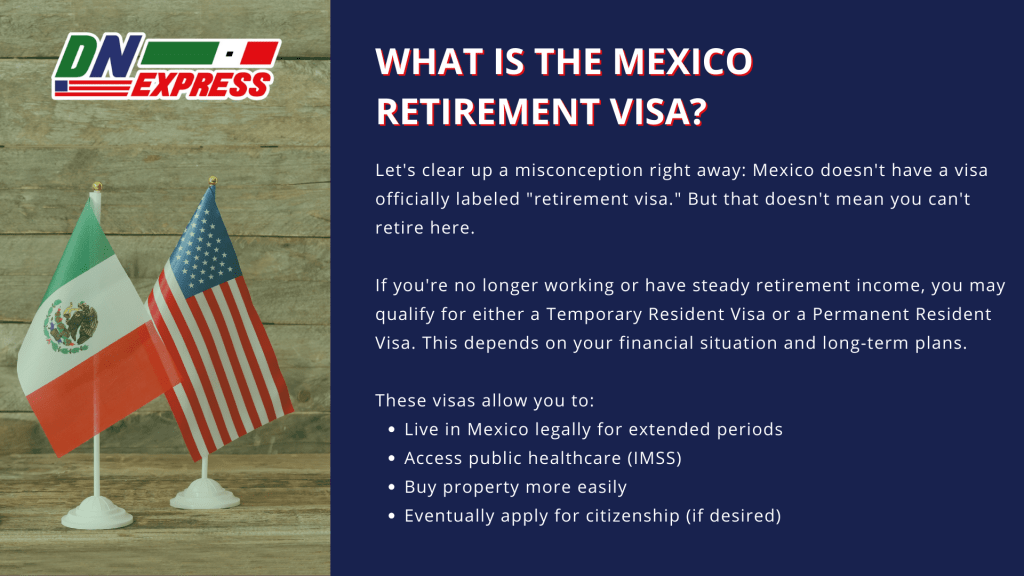
How Much Money Do You Need to Retire in Mexico?
One of the first and most pressing questions retirees ask is: Do I qualify financially? The answer depends on what type of residency visa you apply for and where you apply from.
Financial thresholds are set by each Mexican consulate and can vary significantly.
Temporary Residency
This is the most common path for retirees. To qualify, you'll generally need to show:
- Monthly income of $2,530-$4,600 USD for the past 6 months, or
- Savings of $42,000-$73,000 USD over the past 12 months
Exact amounts change slightly each year and depend on the consulate where you apply.
For detailed information about Mexican residency by economic solvency, consult with qualified professionals who understand current requirements.
Permanent Residency
If you're fully retired and don't plan to work in Mexico, some consulates allow you to apply directly for permanent residency. Requirements are higher:
- $180,000 USD in savings, or
- $4,300+ USD/month in pension income
This route gives you indefinite residency and skips the 4-year temporary visa stage.
Spouses and Dependents
- Add 25% additional income or savings for each dependent you include.
- If you're married to a Mexican citizen, you may qualify without showing economic solvency at all.
Mistake to Avoid: Consulates often reject applications that show joint accounts, online-only bank statements, or funds not clearly under your name. Even minor documentation issues can derail your case.
That's why many applicants turn to Doble Nacionalidad Express to avoid rejection and get it right the first time.
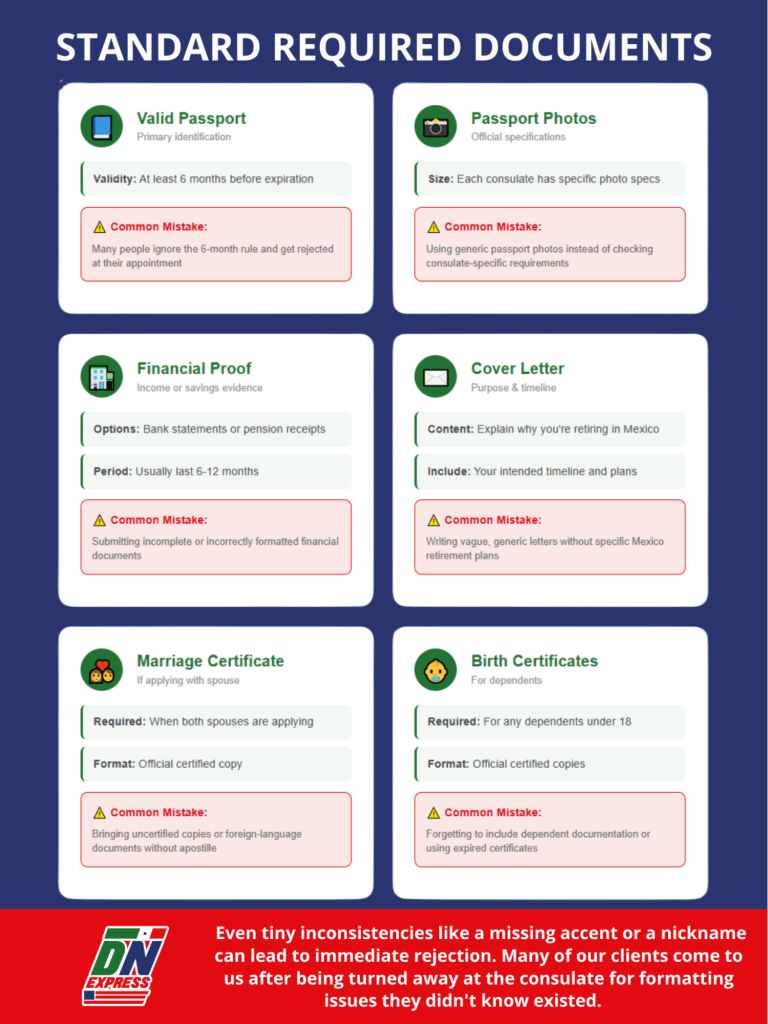
Required Documents (and What People Miss)
Once you meet the financial requirements, it's time to prepare your documents. This is where many applicants slip up.
Here's what you'll need:
Standard Documents
- Valid passport (with at least 6 months before expiration)
- Passport-size photos (each consulate has specific photo specs)
- Proof of income or savings (bank statements or pension receipts)
- Cover letter explaining why you're retiring in Mexico and your intended timeline
- Marriage certificate (if applying with a spouse)
- Birth certificates for any dependents
Document Formatting Matters
- Bank statements must be printed, stamped, and in your name. Online PDFs without verification are often rejected.
- Bring originals and photocopies of all documents.
- Make sure names match across documents exactly. This includes middle names and accents.
❗ Pitfall to Avoid: Even tiny inconsistencies like a missing accent or a nickname can lead to immediate rejection. Many of our clients come to us after being turned away at the consulate for formatting issues they didn't know existed.
We triple-check every document before submission to make sure nothing delays your application. When it comes to legal paperwork in Mexico, details are everything.
For document preparation assistance, including certified translations, professional services can ensure your paperwork meets exact requirements.
Can You Retire on $2,000 a Month?
Absolutely, if you choose the right part of Mexico. While $2,000/month might feel tight in some resort cities, it's sufficient to live comfortably in many inland or mid-sized towns with strong expat communities.
Here's a rough breakdown of what retirees typically spend per month:
- Ajijic / Lake Chapala: $1,800-$2,000 A top retirement spot with cooler climate, walkable neighborhoods, and a vibrant expat scene.
- Mérida (Yucatán) or Oaxaca City: $1,500-$1,800 Both cities offer culture, healthcare, and safety without the beach-town prices.
- San Miguel de Allende: $1,700 A UNESCO World Heritage town with art, charm, and a strong international presence.
Your costs will vary based on:
- Rent (furnished vs. unfurnished)
- Eating out vs. cooking at home
- Local vs. imported goods
- Health insurance choices
If you're working with a $2,000/month budget, skip high-tourism zones like Cancún, Tulum, or Cabo San Lucas. Prices there often mirror U.S. costs and can blow your retirement budget fast.
With smart planning and legal support from professionals like Doble Nacionalidad Express, you can retire in Mexico without sacrificing comfort, safety, or lifestyle.
Can a U.S. Citizen Move to Mexico Permanently?
Yes. Thousands of Americans do it every year.
If you're starting with a Temporary Resident Visa, you can renew it annually for up to four years. After that, you're eligible to apply for Permanent Residency, which means:
- No renewals needed
- No financial solvency requirements
- Freedom to stay in Mexico indefinitely
- Easier access to public services and property ownership
Once you've held permanent residency for five years, you're eligible to apply for Mexican citizenship. You won't need to give up your U.S. passport.
Good to know: Many U.S. citizens mistakenly think they'll lose their American citizenship by becoming Mexican. That's not true. Dual citizenship is allowed by both countries.
If you're ready to make the move for good, Doble Nacionalidad Express can help you plan ahead and guide you through each step. From your first visa to full citizenship.
For comprehensive guidance on moving to Mexico, including residency pathways and citizenship options, professional assistance makes the process smoother.
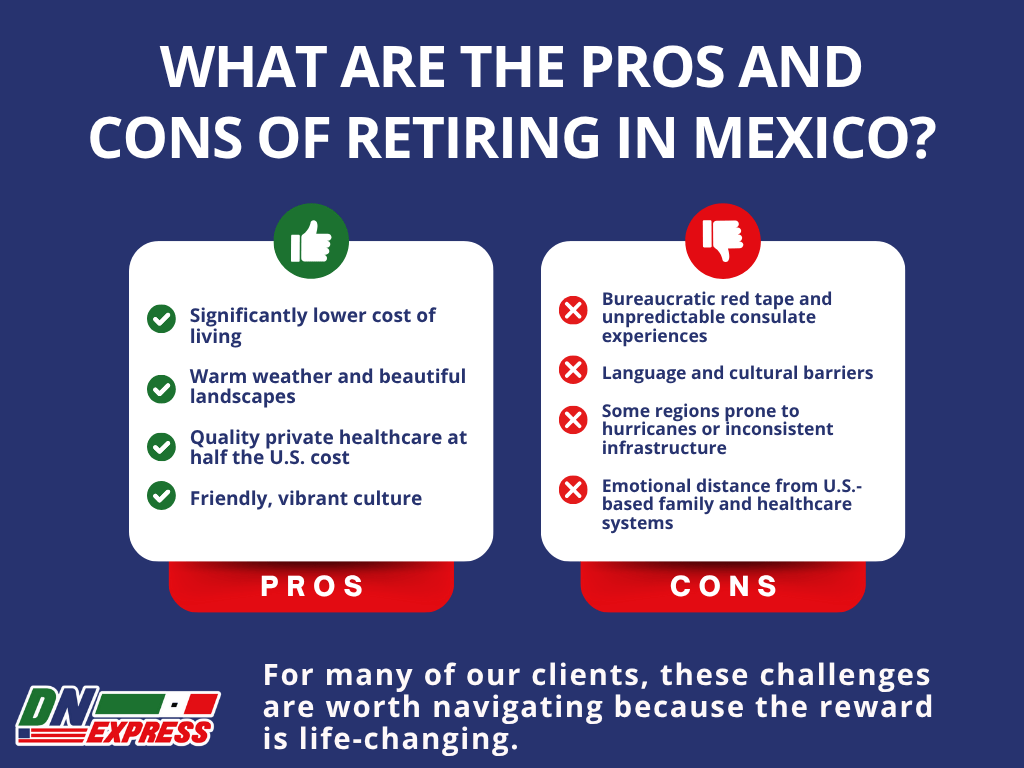
Retirees Worries
If you're seriously thinking about retiring in Mexico, many others have wondered about these same things. Here are some of the most frequent worries we hear from future retirees:
Can I still collect U.S. Social Security in Mexico?
✅ Yes. The Social Security Administration will continue to deposit your payments whether you live in the U.S. or abroad.
You can have your benefits deposited into either a U.S. or Mexican bank account. The U.S.-Mexico Social Security Agreement helps protect your benefits while living abroad.
For assistance with Social Security matters while in Mexico, the U.S. Embassy's Federal Benefits Unit provides support services.
What about Medicare?
❌ Unfortunately, Medicare doesn't cover services in Mexico. You'll need private international insurance or enroll in Mexico's IMSS healthcare system once you become a resident.
The Mexican healthcare system (IMSS) provides coverage for legal residents, though many expats also maintain private insurance for additional options.
Do I have to speak Spanish?
No, but it helps. Many government offices operate only in Spanish, which can be frustrating during legal or medical appointments.
That's why Doble Nacionalidad Express provides bilingual legal support. We help you navigate the process even if you're not fluent.
What if I still work part-time remotely?
You can still qualify for a residency visa based on your income. But be cautious.
You should not generate income from within Mexico unless you have a special work permit. Remote work for U.S. clients is typically fine.
What's the best city if I don't speak Spanish?
Retirees who prefer an English-friendly environment often choose:
- Ajijic — walkable, artsy, and extremely expat-friendly
- Puerto Vallarta — beach city with a large U.S./Canadian retiree population
- Mérida — cultural capital with a growing bilingual community and modern hospitals
Wherever you go, having legal guidance that speaks your language makes all the difference. And that's where DNExpress comes in. Nothing gets lost in translation.
Does Mexico Tax U.S. Retirement Income?
Yes, but it's not as scary as it sounds.
If you become a Mexican tax resident (which typically happens after spending over 183 days in-country), Mexico technically has the right to tax your worldwide income. This includes U.S. retirement benefits, Social Security, and investment income.
But here's the good news:
- The U.S. and Mexico have a tax treaty to avoid double taxation.
- You can claim the Foreign Tax Credit or use the Foreign Earned Income Exclusion (FEIE).
- With the right tax advisor, most retirees pay no additional tax in Mexico beyond what they already pay in the U.S.
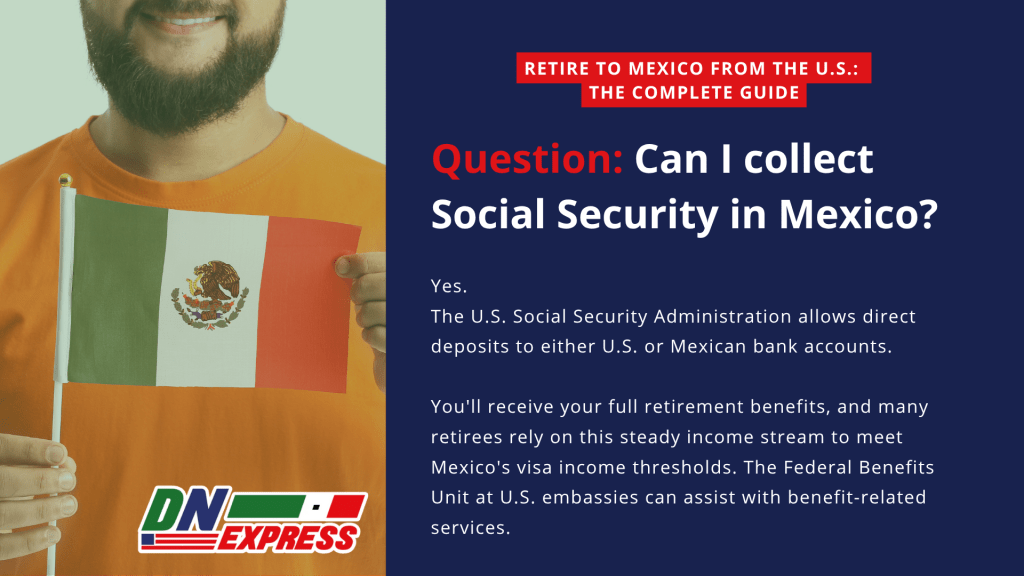
Why DIY Applications Often Fail
Many retirees start the visa process on their own. They often get stuck, delayed, or denied. Here's why:
Pitfalls to Avoid:
- Inconsistent or mismatched documents (names, dates, formats)
- Shared bank accounts or digital-only statements often rejected without explanation
- Unclear intent or missing cover letters
- Conflicting instructions from different consulates
- No bilingual help at INM offices once you're in Mexico
Even well-prepared applicants get blindsided by arbitrary consulate rules or technicalities they didn't know existed.
🧵 “The consulate turned me away for a tiny typo. I gave up until DNExpress fixed it remotely.” — A client story
We see this every week. That's why we built Doble Nacionalidad Express to make sure no one's retirement gets derailed by red tape.
We handle the complexity for you with attorney guidance on both sides of the border.
Why Work With DNExpress?
Retiring abroad should feel exciting, not overwhelming. But too often, families run into closed doors, confusing consulates, and legal processes that feel stacked against them.
That's exactly why we built Doble Nacionalidad Express.
We're not a generic visa service. We're a binational legal team focused on one thing: helping U.S. citizens of Mexican descent and retirees like you secure legal residency and identity in Mexico without stress or surprises.
Here's what sets us apart:
- Skip the consulate entirely — Our licensed attorneys can handle your case remotely.
- Transparent pricing — No bait-and-switch fees, ever.
- Legal guidance — Your documents are reviewed by professionals, not bots or form-fillers.
- We specialize in complex and rejected cases — You're not starting from scratch with us.
- Bilingual support via WhatsApp, calls, or email — No miscommunications.
- Trusted by over 3,000 families in California, Texas, Illinois, and across the U.S.
Think ahead: Getting residency now opens the door to Mexican citizenship, public healthcare access, property rights, and even inheritance protections for your family in the future.
When you're ready to make your move to Mexico, DNExpress is ready to make it simple, legal, and right the first time.
To learn about our services and pricing, or to get answers to specific questions, visit our FAQ section.
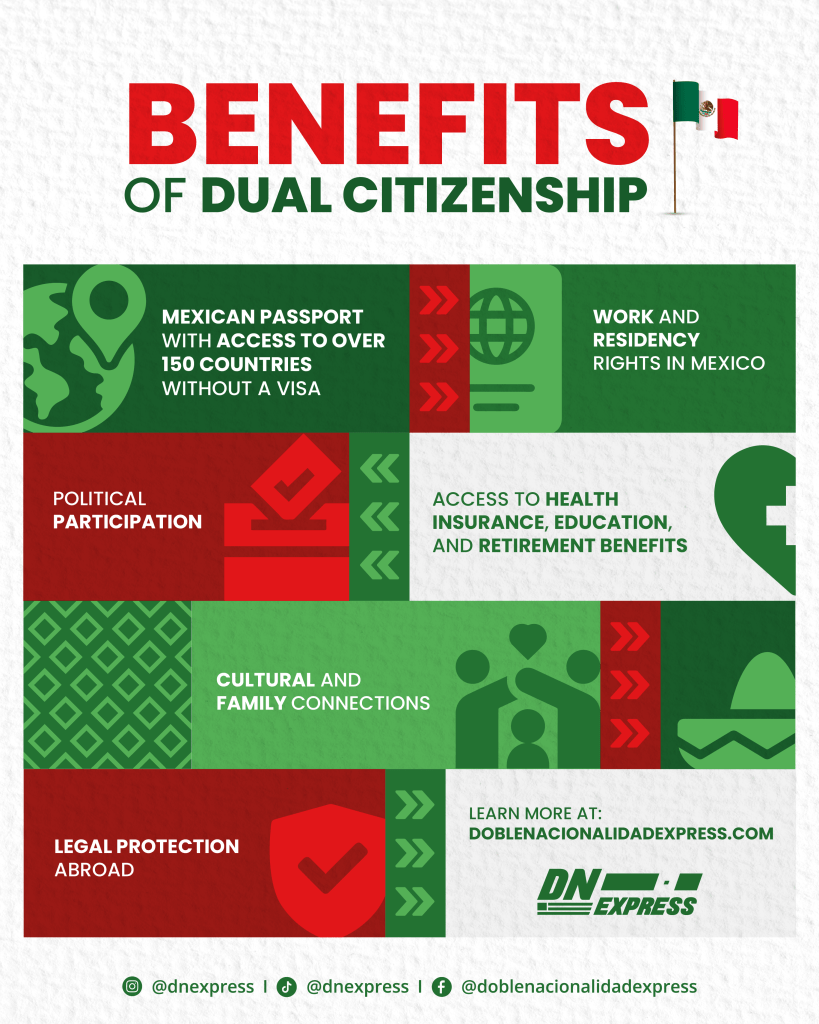
Benefits of Obtaining Dual Citizenship
Your Next Step to Retiring in Mexico
Whether you're dreaming of slower mornings, sunnier weather, or reconnecting with your roots, retiring in Mexico is achievable. You don't have to navigate it alone.
With the right legal support, you can skip the confusion, avoid rejections, and start your new chapter with confidence. Doble Nacionalidad Express has helped thousands of families make that leap. Legally, affordably, and with heart.
If you're ready to retire in Mexico the right way:
We'll take care of the paperwork so you can focus on the life you came here to live.
Before making your move, it's wise to review the current U.S. State Department travel advisories for Mexico and ensure you understand safety considerations and entry requirements.
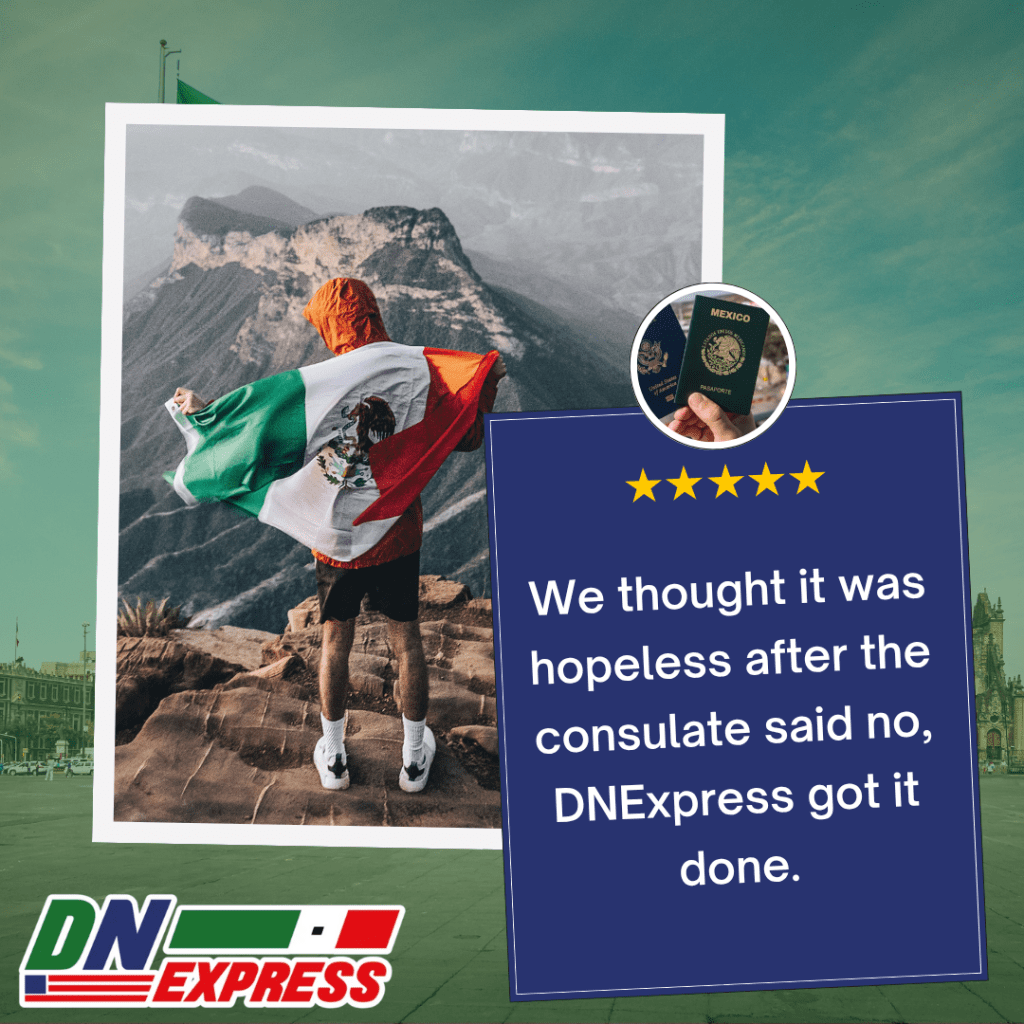
FAQ
Can I get a retirement visa in Mexico without going to the consulate?
Yes, in many cases, yes. DNExpress helps eligible retirees handle the entire process remotely. This avoids long wait times, rude staff, and confusing paperwork at the consulate.
Is there an age requirement for the Mexico retirement visa?
No. Mexico's residency visas are based on economic solvency, not age. You can apply at any time as long as you meet the income or savings requirements.
Will I lose my U.S. citizenship if I become a permanent resident or citizen of Mexico?
Absolutely not. Both the U.S. and Mexico allow dual citizenship, so you can legally hold both without giving anything up.
Can I include my spouse in my retirement visa application?
Yes. Spouses and dependents can be added, usually by showing 25% additional income or savings. If you're married to a Mexican citizen, you may not need to show financials at all.
How long does it take to get Mexican residency?
With DNExpress, many clients receive their residency card within days of completing their biometrics in Mexico. We help prepare everything ahead of time so there are no surprises or delays.
For specific information about Social Security benefits while living abroad, consult the official USAGov guidance to understand your rights and obligations.



